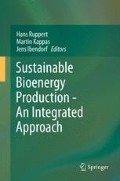Abstract
Contaminated arable land should not be used for the production of food or forage crops but for bioenergy production. As it takes thousands of years for plants to extract enough harmful metals from contaminated soils to reach acceptable low levels (phytoremediation), it is more feasible to leave the toxic elements in the soil. The metal transfer from various kinds of polluted soils to a variety of energy crops was investigated to identify crops with a low metal uptake. The advantages of using slightly contaminated crops for biogas production are that the heavy metals in the biogas plant will not impair the fermentation process. Furthermore, the residues of the biogas production can be returned to the fields where the crops were harvested. All important nutrients are recycled back into the fields (except nitrogen) without exceeding the maximum permissible values for heavy metal of farm fertilisers. Possible energy crops that show a low uptake of toxic elements are: the maize cultivars Padrino and Amadeo, the rye cultivar Vitallo and the barley cultivar Christelle. In contrast, amaranth (spec.) sunflower, the energy beet Kyros, the grass hybrid Miscanthus giganteus and sunchoke should not be cultivated on contaminated soils for bioenergy production due to their high cadmium uptake.
Access this chapter
Tax calculation will be finalised at checkout
Purchases are for personal use only
References
Amon, T., Machmüller, A., Kryvoruchko, V., Milovanovic, D., Hrbek, R., Eder, M. W., & Stürmer, B. (2006). Endbericht Forschungsprojekt: Optimierung der Methanausbeute aus Zuckerrüben, Silomais, Körnermais, Sonnenblumen, Ackerfutter, Getreide, Wirtschaftsdünger und Rohglyzerin unter den Standortbedingungen der Steiermark. Retrieved August 29, 2012, from http://www.noest.or.at/intern/dokumente/098_ZB_Optimierung_Biogaserzeugung.pdf
Breitschuh, G., Reinhold, G., & Breitschuh, T. (2006). Ökologische Konsequenzen (einschließlich CC) des Anbaus und der Verwendung nachwachsender Biogasrohstoffe. Thüringer Landesanstalt für Landwirtschaft (TLL) Jena-Zwätzen, 10 p. Retrieved August 29, 2012, from http://www.tll.de/ainfo/pdf/bio20206.pdf
Deicke, M., Ruppert, H., & Schneider, J. (2006). Mining and smelting in the Harz mountains (Germany) – A never-ending environmental story. Schriftenreihe der Deutschen Gesellschaft für Geowissenschaften, 45, 237–256.
FAO (Food and Agriculture Organization of the United Nations). (2012). FAO statistical Yearbook 2012. Retrieved July 30, 2012, from http://www.fao.org/economic/ess/ess-publications/ess-yearbook/yearbook2012/en/
FNR (Fachagentur Nachwachsende Rohstoffe). (2012). Basisdaten Bioenergie Deutschland. 51 pp. Retrieved August 29, 2012, from http://mediathek.fnr.de/media/downloadable/files/samples/f/n/fnr_basisdaten_2012_web.pdf
Förstner, U., & Müller, G. (1974). Schwermetalle in Flüssen und Seen als Ausdruck der Umweltverschmutzung (225 pp.). Berlin: Springer.
Iskandar, I. K (Ed., 2001). Environmental restoration of metals-contaminated soils (304 pp.). Boca Raton: Lewis Publishers.
Kabata-Pendias, A. (2010). Trace elements in soils and plants (4th Rev. ed., 520 pp.). Boca Raton/London/New York: CRC Press/Taylor & Francis Group.
Kloke, A. (1984). Problematik von Orientierungs-, Richt- und Grenzwerten für Schwermetalle in biologischen Substanzen. In Schutz des Umweltmediums Boden. Evangelische Akademie Loccum, 10.-12.02.1984, 61–119.
Kloke, A., Sauerbeck, D. R., & Vetter, H. (1984). The contamination of plants and soils with heavy metals and the transport of metals in terrestrial food chains. In J. O. Nriagu (Ed.), Changing metal cycles and human health (pp. 113–142). Berlin, Heidelberg, New York, Tokyo: Springer.
Knappe, F., Möhler, S., Ostermayer, K., Lazar, S., & Kaufmann, C. (2008). Vergleichende Auswertung von Stoffeinträgen in Böden über verschiedene Eintragspfade. Umweltbundesamt Texte 36/08, 410 pp., Umweltbundesamt, Dessau (Germany); ISSN 1862–4804; Retrieved August 29, 2012, from http://www.umweltdaten.de/publikationen/fpdf-l/3644.pdf
Li, Z., Mclaren, R. G., & Meiherell, A. K. (2004). The availability of native and applied soil cobalt to ryegrass in relation to soil cobalt and manganese status and other soil properties. New Zealand Journal of Agricultural Research, 47, 33–43.
Luo, D., Zheng, H., Chen, Y., Wang, G., & Fenghua, D. (2010). Transfer characteristics of cobalt from soil to crops in the suburban areas of Fujian province, southeast China. Journal of Environmental Management, 91, 2248–2253.
Raskin, I,. & Ensley, B. D. (2000). Phytoremediation of toxic metals – Using plants to clean up the environment (304 pp.). New York: Wiley.
Salt, C. (1998). Schwermetalle in einem Rieselfeld-Ökosystem. Landschaftsentwicklung und Umweltforschung. Schriftenreihe des Fachbereichs Landschaftsentwicklung der TU Berlin, 53, 214 pp.
Sauer, B. (2009). Elementgehalte und Stoffströme bei der Strom- und Wärmegewinnung im Bioenergiedorf Jühnde. Schriftenreihe Fortschritt neu denken, Heft 2 (124 pp.). Göttingen, Institut für Bioenergiedörfer Göttingen e. V. (Germany). ISSN 2190–7722.
Sauerbeck, D. (1989). Der Transfer von Schwermetallen in die Pflanze. – In Beurteilung von Schwermetallkontaminationen in Böden. In D. Behrens & J. Wiesner (Eds.), Dechema- Fachgespräche Umweltschutz (pp. 281–316). Dechema Gesellschaft für Chemische Technik und Biotechnologie e. V, Frankfurt.
Sauerbeck, D., & Lübben, S. (1991). Auswirkungen von Siedlungsabfällen auf Böden, Bodenorganismen und Pflanzen. Berichte aus der Ökologischen Forschung, Band 6. Jülich: Forschungszentrum Jülich GmbH, ISSN 0939–4931.
Suthersan, S. S. (1997). Remediation engineering (362 pp.). Boca Raton: Lewis Publishers.
Wenzel, W. W., Lombi, E., & Adriano, D. C. (1999). Biogeochemical processes in the rhizosphere: Role in phytoremediation of metal-polluted soils. In M. N. V. Prasad & J. Hagemeyer (Eds.), Heavy metal stress in plants (pp. 273–304). Heidelberg: Springer.
Young, D., Kanae, S., Oki, T., Koike, T., & Musiake, K. (2003). Global potential soil erosion with reference to land use and climate changes. Hydrological Processes, 17, 2913–2928.
Author information
Authors and Affiliations
Corresponding author
Editor information
Editors and Affiliations
Rights and permissions
Copyright information
© 2013 Springer Science+Business Media Dordrecht
About this chapter
Cite this chapter
Sauer, B., Ruppert, H. (2013). Bioenergy Production as an Option for Polluted Soils – A Non-phytoremediation Approach. In: Ruppert, H., Kappas, M., Ibendorf, J. (eds) Sustainable Bioenergy Production - An Integrated Approach. Springer, Dordrecht. https://doi.org/10.1007/978-94-007-6642-6_14
Download citation
DOI: https://doi.org/10.1007/978-94-007-6642-6_14
Published:
Publisher Name: Springer, Dordrecht
Print ISBN: 978-94-007-6641-9
Online ISBN: 978-94-007-6642-6
eBook Packages: Earth and Environmental ScienceEarth and Environmental Science (R0)

